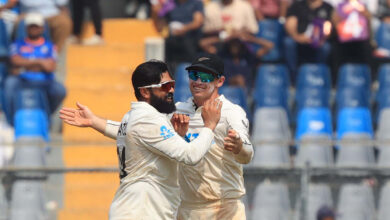Malaysia Open badminton: How Ashwini Ponnappa-Tanisha Crasto pulled off a huge win against former world champions | Badminton News

An arching parabola of a floated return from Ashwini Ponnappa, timed from her backcourt to drop slowly and lull the opponents. Followed immediately a scything smash, hit brutally flat and fast and rushing on them Tanisha Crasto, looming like a storm from the front court.The Indian pairing used their in-rally changes in pace and waves upon waves of this 1-2 routine marvelously to scramble the minds of former World No 1s and twice World champions, Mayu Matsumoto and Wakana Nagahara, winning 21-19, 13-21, 21-15 at Malaysia Open Super 1000 on Wednesday.
Olympic qualification is the obvious target this year. But you reckon Ashwini’s are not the small, limited dreams of merely pipping Treesa Jolly-Gayatri Gopichand and finishing as the best Indians. There are tougher Chinese and Japanese to slay beyond the mere Indian duels of the qualification bubble. Like she did with Jwala Gutta in 2012 and 2016, the now 34-year-old wants to steer the 20-year-old Tanisha into seriously challenging the top names.
Ashwini’s even bitten back her instinct to rain down smashes like hell breaking loose, allowing Tanisha to attack, while she focuses on patience and placements and loopy patterns to confuse opponents. “I have to play patient, no? I just can’t rely on hard smashes and go boom-boom-boom. I won’t survive if I do that so have to play smarter, and sustain a full women’s doubles match,” said the one-time record holder of the fastest smash in women.
#MalaysiaOpenSuper1000
What a result that is in women’s doubles! Ashwini Ponnappa and Tanisha Crasto have defeated former world champs & world no 9 Matsumoto and Nagahara in three games. Huge win, another shot in the arm for their Paris hopes. 👌🏾👌🏾👌🏾https://t.co/eg1g6HN2zl pic.twitter.com/gtOyfUHooD
— Vinayakk (@vinayakkm) January 11, 2024
Japanese pairings seldom play sharp, their game is one of consency game, and they stretch rallies endlessly. But the biggest Indian achievement in this second-round win in Kuala Lumpur was just how many times Ashwini-Tanisha got the seventh seeds to lose their defensive shape at the end of long rallies. And Naga-Matsu, as they are commonly known, ended up on the same side of the court corners, with anarchy induced into their returns the canny, quick Indians. Their striking patterns were video-gamesque.
Tanisha’s badminton is breathless to watch – coach Arun Vishnu informs the two are regularly hitting heart-rate scores of 190 now. She dives frantically, and has remnants of a clumsy defense that will get better with anticipation. But her attacking glee even from imbalanced positions, the body contortions she routinely gets into, to thwack at the shuttle no matter what, gave the Japanese one right headache on the day. This one time she squat-slashed with quite the venom to scare Matsumoto.
The big plan was to take the lead early, and guard it zealously. From the favourable side, the Indians pulled away at 6-6 in the first. Conditions were conducive to hard-hitting, and like Cap America tells Hulk to follow one plan: Smash, Ashwini knew what this tough Round of 16 clash needed. “Against the big teams, there’s only one way to approach: go all in all guns blazing,” she said.
She’s not quite as flash as Chirag Shetty, but Tanisha is getting there, in razoring across to the front court corner and killing the bird with a swat. While Ashwini played the short crosses from the back, Tanisha blitzed at the front and found herself the whole court to attack with steep smashes from the front right corner as they took off to 19-16. Having full faith in their attack, they weren’t scared to lift high, but smartly. Ashwini would bring her forearm racquet control into play, to manoeuvre the shuttle for breadth and height. “The angles were planned, and I’ve been accepting of change,” said the senior pro, who’s added a bunch of variations from the back. The floaty winners don’t merely punctuate her smashes anymore, but are set-up shots.
At 17-16, Ashwini went after Matsumoto like a heat-map missile, peppering her with body shots all around the court. The 5’10” Japanese, once a livewire, has slowed down considerably, but Ashwini-Tanisha were relentless in hassling her. “We knew she rushes a bit, so it was important to pin her to the backcourt,” Ashwini said. Tanisha took over in the third, and at 20-15 the Indians crowded the Japanese with pace on down strokes, before Tanisha slashed one at Matsumoto.
In the mid-game, the Indians took the foot off the pedal a tad, and playing from the tough side, moved a touch slow. At the start of decider, the switch flicked, and Tanisha began attacking the second shuttle more aggressively. They wouldn’t let go of the lead from there. “That early lead was crucial. We held our nerve to not get carried away with the lead, or let the head get too far ahead. We were disciplined,” Ashwini said.
A big smile did the trick for Tanisha Crasto/Ashwini Ponnappa 🇮🇳 against the 7️⃣th seeds.#BWFWorldTour #MalaysiaOpen2024 https://t.co/b1R1N8xJBp pic.twitter.com/kr4yLE2NSS
— BWF (@bwfmedia) January 11, 2024
Court mops were used cleverly for parleys in the first set at 20-19, and Tanisha bisected the Japanese to seal the opener. Start of the third, she had her bent knee reflex returns when the Japanese changed the length. The lifts to the back, Tanisha’s short snappy smashes and the body attacks on an awkward hip length were the recurring tropes. The Japanese were brought together decade and half ago because both were tall. The Indians today used their height against them forcing them into cramped body defense. Matsumoto was a hassled soul at 15-13 and 16-13 in the third when the Indians went after her. Ultimately, it was one of Tanisha’s rizz serves that saw Wakana stab the shuttle into the net.
While coach Arun Vishnu would laud Tanisha for her patience and improved defense, Ashwini was all praise for her grasping power. “She’s come a long way and has a long way to go still. But she understands game plan changes fast and though we both make makes, Tanisha has learnt to snap out of it and focus on the next point. My confidence in Tanisha has increased a lot,” she said of the star of the day.
Indians always matched the Japanese in rallies, and Ashwini has even beaten this pairing alongside Jwala. But consency was a bane. India’s never had two Top 20 doubles pairings in women either, which might happen next week. The biggest acknowledgment comes from Arun Vishnu, who started out skeptically as coach to Ashwini-Tanisha and Treesa-Gayatri, but now is immersed in their ambitions.
“I’ll be honest in 2016 when I started coaching, and they were juniors, I never liked watching women’s doubles or understood how the top pairings managed to keep the rallies going forever. I’ve learnt with them, and now I’ve watched so much women’s doubles and enjoy it like anything,” says the former men’s doubles shuttler, who had to completely change training for the women’s game. “Now it’s almost like I’m playing the women’s game, learning patience and grace, I’m that invested in the four doing well.”




